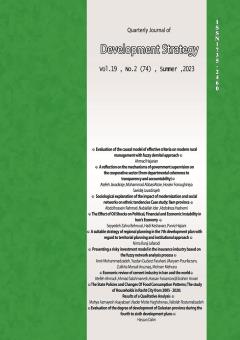-
-
List of Articles
-
Open Access Article
1 - Evaluation of the causal model of effective criteria on modern rural management with fuzzy demitel approach
ahmad hajarian -
Open Access Article
2 - A reflection on the mechanisms of government supervision on the cooperative sector (from departmental coherence to transparency and accountability)
atefeh javadi raje Abbasi atoie Mohammad Hossein Foroughiniya saeedeh javadi raje -
Open Access Article
3 - Sociological explanation of the impact of modernization and social networks on ethnic tendencies Case study: Ilam province
Abdolhossein Rahmati نبی اله ایدر Abdolreza Hashemi -
Open Access Article
4 - The Effect of Oil Shocks on Political, Financial and Economic Instability in Iran's Economy
Seyyedeh Zahra Behrouzi دکتر هادی کشاورز Parviz Hajiani -
Open Access Article
5 - A suitable strategy of regional planning in the 7th development plan with regard to territorial planning and institutional approach
نیمارنجی جفرودی -
Open Access Article
6 - Presenting a risky investment model in the insurance industry based on the fuzzy network analysis process
Amir Mohammadzade Yazdan Gudarzi Farahani مریم پورفرزام Zulikha Morsali Aruznaq Mohsen Mehrara -
Open Access Article
7 - Economic review of cement industry in Iran and the world
atefeh ahmadi Ahmad Salahmanesh hasan farazmand Ebrahim Anvari -
Open Access Article
8 - The State Policies and Changes Of Food Consumption Patterns; The study of Households in Rasht City from 2005 - 2020: Results of a Qualitative Analysis
mahya azmayesh asyabsari Nader Motie Haghshenas valiolah rostamalizadeh, -
Open Access Article
9 - Evaluation of the degree of development of Golestan province during the fourth to sixth development plans
دليري daler
-
The rights to this website are owned by the Raimag Press Management System.
Copyright © 2017-2026







